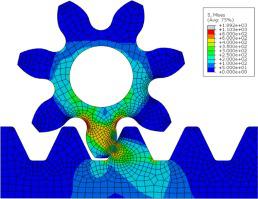Engineering Failure Analysis ( IF 4 ) Pub Date : 2020-06-02 , DOI: 10.1016/j.engfailanal.2020.104623 Khondaker Sakil Ahmed , Ang Kok Keng , Koh Chan Ghee

|
In offshore mobile jack-up rig, platforms are generally supported by movable jacking system in which strength of rack and pinion are very crucial in determining the design life of the superstructure. In this study, a series of finite element (FE) models has been developed and analysed for a 7-teeth pinion with rack to investigate the strength, stiffness and fatigue life of the jacking system before its practical application in an offshore rig. Since rack/pinion contact patterns change with the rotation of the shaft, FE models are developed for each 10-degree rotations starting from 0 to 50 degree where elasto-plastic properties of both rack and pinion are considered in the FE analyses. A geometric analysis is also performed to determine shape and contact position between the rack and pinion at different angle of rotation. Finite element analyses are conducted for worst possible load cases of the jacking system including self-weight of the platform, wind load, hydrodynamics force as per American Bureau of Shipping (ABS) guideline. The stress distribution of the pinion shows that maximum stress occurs at the root of the tooth, mainly due to bending effect resulting from external torque. The FE analysis reveals that maximum von mises stress of pinion and rack are found to be 1105 MPa and 688 MPa, respectively which are very close to the corresponding strength of the materials. The FE results are validated with the established Lewis formula and American Gear Manufacturers Association (AGMA) guideline. Considering the design life of the offshore platform, fatigue performance of the pinion is investigated for different operational loading of the platform. A separate 3D FE model has been developed to check the stiffness of the gear box that actually presents the serviceability of shaft beam and pinion teeth. In the stiffness analysis, the maximum deflection of the beam and individual tooth are found to be 1.2 mm and 2.1 mm, respectively. The outcome of this study is expected to contribute in designing future rack/pinion system for offshore jack-up rigs and similar other structures.
中文翻译:

海上自升式钻机的7齿小齿轮/机架顶升系统的应力和刚度分析
在海上移动自升式钻机中,平台通常由可移动顶升系统支撑,在该系统中,齿条和小齿轮的强度对于确定上部结构的设计寿命至关重要。在这项研究中,已经开发了一系列有限元(FE)模型,并对带有齿条的7齿小齿轮进行了分析,以研究顶升系统在海上钻井平台实际应用之前的强度,刚度和疲劳寿命。由于齿条/小齿轮的接触方式随轴的旋转而变化,因此从0度到50度每旋转10度都会开发有限元模型,在有限元分析中考虑齿条和小齿轮的弹塑性。还执行几何分析,以确定在不同旋转角度下齿条与小齿轮之间的形状和接触位置。对起重系统的最坏负载情况进行了有限元分析,包括平台自重,风载荷,水力(根据美国运输局(ABS)指南)。小齿轮的应力分布表明,最大应力出现在牙齿的根部,主要是由于外部扭矩引起的弯曲作用。有限元分析表明,小齿轮和齿条的最大冯密斯应力分别为1105 MPa和688 MPa,非常接近材料的相应强度。有限元结果已通过已建立的Lewis公式和美国齿轮制造商协会(AGMA)指南进行了验证。考虑到海上平台的设计寿命,研究了平台在不同操作载荷下小齿轮的疲劳性能。已经开发了一个单独的3D FE模型来检查齿轮箱的刚度,该刚度实际上代表了轴梁和小齿轮的使用寿命。在刚度分析中,发现梁和单个齿的最大挠度分别为1.2 mm和2.1 mm。预期这项研究的结果将有助于为海上自升式钻井平台和类似其他结构设计未来的齿条/小齿轮系统。



























 京公网安备 11010802027423号
京公网安备 11010802027423号